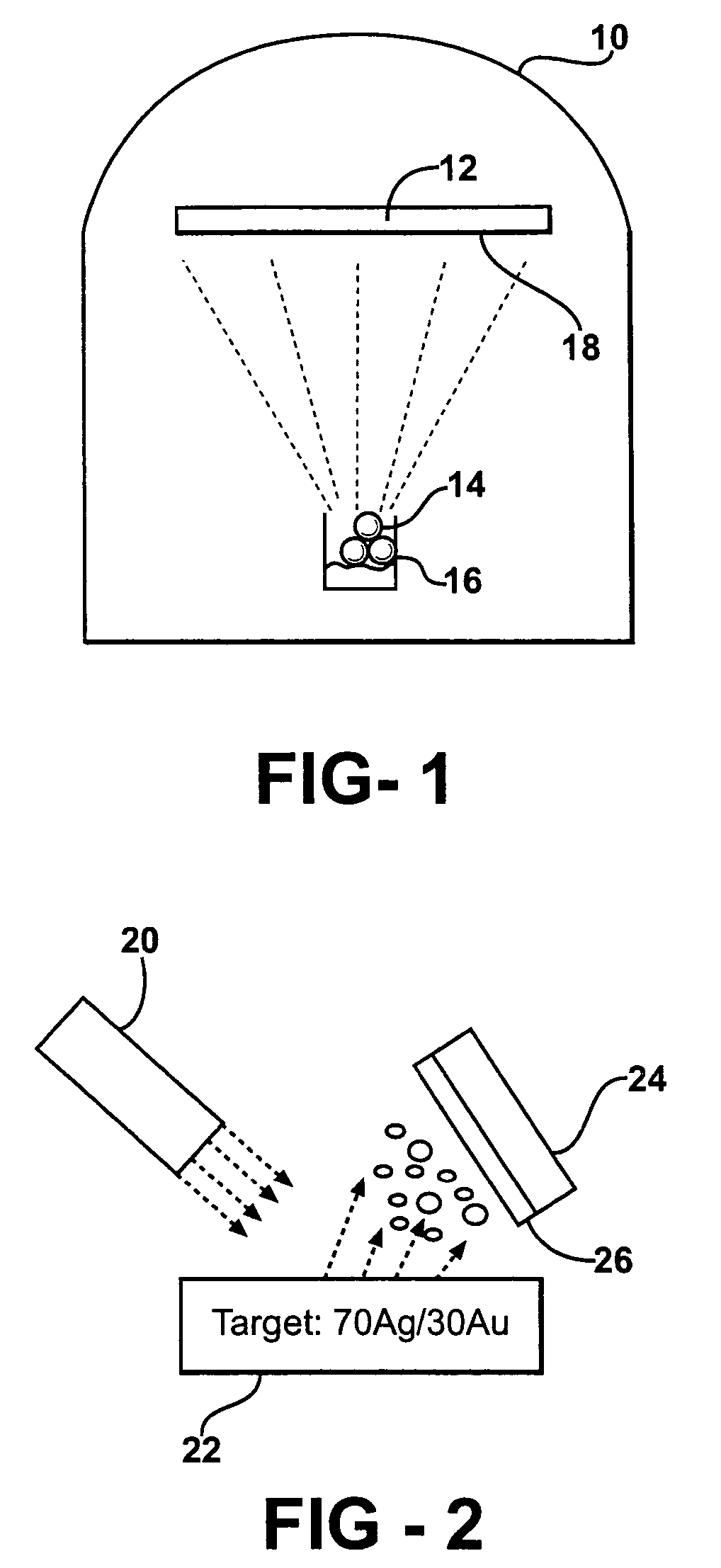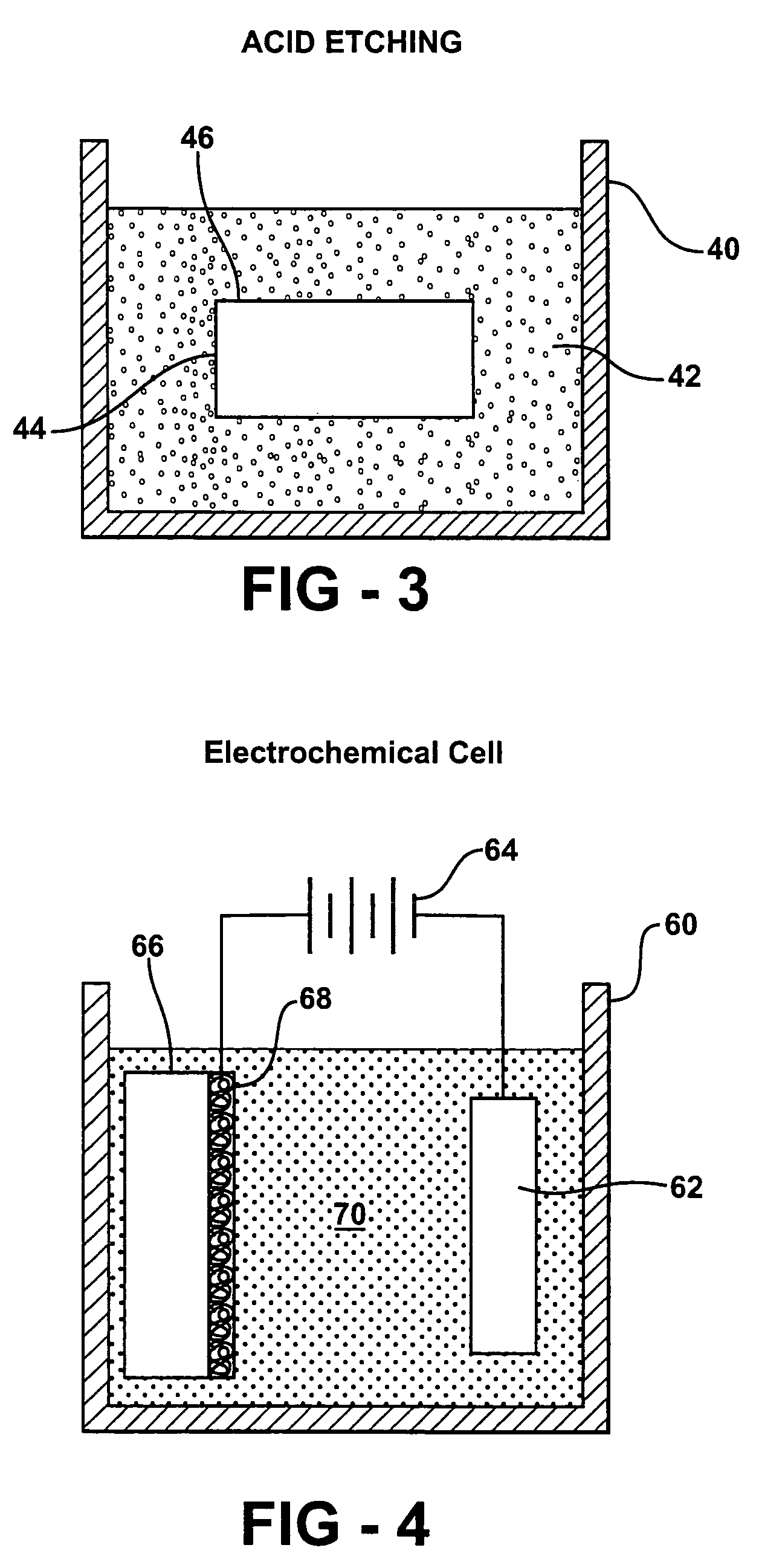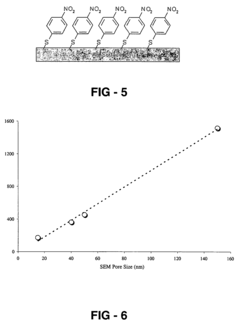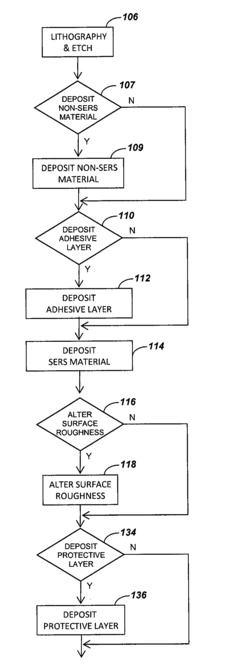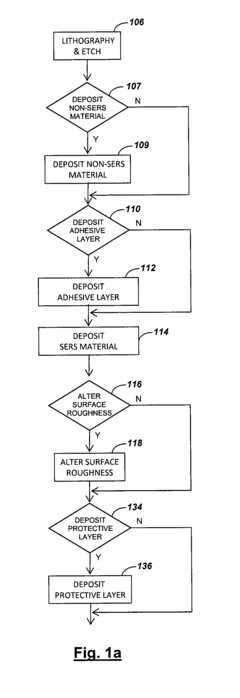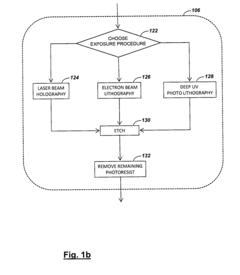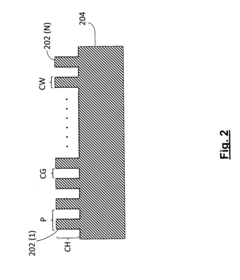Comparative Analysis of SERS Substrates and Carbon-Based Substrates
OCT 1, 202510 MIN READ
Generate Your Research Report Instantly with AI Agent
Patsnap Eureka helps you evaluate technical feasibility & market potential.
SERS and Carbon Substrate Technology Background and Objectives
Surface-Enhanced Raman Spectroscopy (SERS) has evolved significantly since its discovery in the 1970s, revolutionizing molecular detection capabilities through enhanced Raman scattering. This phenomenon occurs when molecules adsorb onto specially prepared metal surfaces, typically gold or silver nanostructures, resulting in signal amplification factors of 10^6 to 10^14. The historical trajectory of SERS development has progressed from initial observations on roughened electrodes to sophisticated engineered substrates with precise nanostructures designed for optimal enhancement.
Carbon-based substrates represent a parallel technological development that has gained significant attention in recent years. These materials, including graphene, carbon nanotubes, and various carbon composites, offer unique properties that complement traditional metallic SERS substrates. The evolution of carbon nanomaterials has accelerated since the isolation of graphene in 2004, opening new possibilities for sensing applications that leverage both the electronic properties of carbon and the plasmonic properties of metals.
The convergence of these two technological domains—SERS and carbon-based materials—presents a promising frontier for advanced sensing applications. Current research trends indicate growing interest in hybrid structures that combine the plasmonic enhancement capabilities of noble metals with the exceptional physical and chemical properties of carbon nanomaterials. These hybrid approaches aim to overcome limitations inherent to traditional SERS substrates, such as stability issues, reproducibility challenges, and limited substrate versatility.
The primary technical objectives of this comparative analysis are threefold. First, to systematically evaluate the enhancement mechanisms in both traditional metallic SERS substrates and emerging carbon-based alternatives, identifying the fundamental physical principles that govern their performance. Second, to assess the practical aspects of these substrates including fabrication complexity, cost-effectiveness, stability under various environmental conditions, and reproducibility of enhancement factors. Third, to explore the potential synergies between these substrate types through hybrid approaches that may yield superior analytical performance.
Looking forward, the field is moving toward multifunctional SERS platforms that not only provide signal enhancement but also offer additional functionalities such as molecular selectivity, integrated separation capabilities, and compatibility with portable detection systems. The ultimate goal is to develop next-generation SERS substrates that combine the best attributes of both metallic and carbon-based materials, enabling highly sensitive, selective, and reliable molecular detection across diverse application domains including environmental monitoring, food safety, biomedical diagnostics, and security screening.
This analysis aims to provide a comprehensive technological roadmap that illuminates the comparative advantages and limitations of different substrate approaches, guiding future research and development efforts in this rapidly evolving field.
Carbon-based substrates represent a parallel technological development that has gained significant attention in recent years. These materials, including graphene, carbon nanotubes, and various carbon composites, offer unique properties that complement traditional metallic SERS substrates. The evolution of carbon nanomaterials has accelerated since the isolation of graphene in 2004, opening new possibilities for sensing applications that leverage both the electronic properties of carbon and the plasmonic properties of metals.
The convergence of these two technological domains—SERS and carbon-based materials—presents a promising frontier for advanced sensing applications. Current research trends indicate growing interest in hybrid structures that combine the plasmonic enhancement capabilities of noble metals with the exceptional physical and chemical properties of carbon nanomaterials. These hybrid approaches aim to overcome limitations inherent to traditional SERS substrates, such as stability issues, reproducibility challenges, and limited substrate versatility.
The primary technical objectives of this comparative analysis are threefold. First, to systematically evaluate the enhancement mechanisms in both traditional metallic SERS substrates and emerging carbon-based alternatives, identifying the fundamental physical principles that govern their performance. Second, to assess the practical aspects of these substrates including fabrication complexity, cost-effectiveness, stability under various environmental conditions, and reproducibility of enhancement factors. Third, to explore the potential synergies between these substrate types through hybrid approaches that may yield superior analytical performance.
Looking forward, the field is moving toward multifunctional SERS platforms that not only provide signal enhancement but also offer additional functionalities such as molecular selectivity, integrated separation capabilities, and compatibility with portable detection systems. The ultimate goal is to develop next-generation SERS substrates that combine the best attributes of both metallic and carbon-based materials, enabling highly sensitive, selective, and reliable molecular detection across diverse application domains including environmental monitoring, food safety, biomedical diagnostics, and security screening.
This analysis aims to provide a comprehensive technological roadmap that illuminates the comparative advantages and limitations of different substrate approaches, guiding future research and development efforts in this rapidly evolving field.
Market Applications and Demand Analysis for SERS Technologies
The Surface-Enhanced Raman Spectroscopy (SERS) technology market has experienced significant growth in recent years, driven by increasing demand for highly sensitive detection methods across multiple industries. The global SERS market was valued at approximately 1.2 billion USD in 2022 and is projected to reach 2.5 billion USD by 2028, representing a compound annual growth rate of 13.2% during the forecast period.
Healthcare and life sciences represent the largest application segment for SERS technologies, accounting for nearly 40% of the market share. Within this sector, there is growing demand for SERS-based diagnostic tools capable of detecting biomarkers at ultra-low concentrations, enabling early disease detection and personalized medicine approaches. Pharmaceutical companies are increasingly adopting SERS for drug discovery and development processes, particularly for analyzing molecular interactions and drug delivery mechanisms.
Food safety and environmental monitoring constitute another significant market segment, collectively representing approximately 30% of SERS applications. Regulatory agencies worldwide are implementing stricter safety standards, creating demand for rapid, sensitive detection methods for contaminants, pesticides, and pathogens. The ability of SERS to detect trace amounts of harmful substances makes it particularly valuable in these fields.
Security and forensic applications account for roughly 15% of the market, with growing implementation in explosive detection, narcotics identification, and document verification. The non-destructive nature of SERS analysis provides a significant advantage in forensic investigations where sample preservation is critical.
Regionally, North America dominates the SERS market with approximately 35% share, followed by Europe (30%) and Asia-Pacific (25%). However, the Asia-Pacific region is expected to witness the fastest growth due to increasing research funding, expanding industrial applications, and growing awareness of advanced analytical techniques.
The demand for different SERS substrate types varies by application. Metal-based substrates (particularly gold and silver) currently dominate commercial applications due to their established enhancement capabilities. However, carbon-based substrates are gaining significant market interest due to their potential cost advantages, stability, and biocompatibility. Industry analysts predict that carbon-based SERS substrates could capture up to 20% of the market by 2026, particularly in biomedical and environmental applications where their unique properties offer distinct advantages.
End-user preferences are increasingly shifting toward portable, field-deployable SERS systems, creating new market opportunities for integrated substrate-instrument solutions. This trend is particularly evident in environmental monitoring, food safety, and point-of-care diagnostics, where rapid on-site analysis provides significant operational advantages.
Healthcare and life sciences represent the largest application segment for SERS technologies, accounting for nearly 40% of the market share. Within this sector, there is growing demand for SERS-based diagnostic tools capable of detecting biomarkers at ultra-low concentrations, enabling early disease detection and personalized medicine approaches. Pharmaceutical companies are increasingly adopting SERS for drug discovery and development processes, particularly for analyzing molecular interactions and drug delivery mechanisms.
Food safety and environmental monitoring constitute another significant market segment, collectively representing approximately 30% of SERS applications. Regulatory agencies worldwide are implementing stricter safety standards, creating demand for rapid, sensitive detection methods for contaminants, pesticides, and pathogens. The ability of SERS to detect trace amounts of harmful substances makes it particularly valuable in these fields.
Security and forensic applications account for roughly 15% of the market, with growing implementation in explosive detection, narcotics identification, and document verification. The non-destructive nature of SERS analysis provides a significant advantage in forensic investigations where sample preservation is critical.
Regionally, North America dominates the SERS market with approximately 35% share, followed by Europe (30%) and Asia-Pacific (25%). However, the Asia-Pacific region is expected to witness the fastest growth due to increasing research funding, expanding industrial applications, and growing awareness of advanced analytical techniques.
The demand for different SERS substrate types varies by application. Metal-based substrates (particularly gold and silver) currently dominate commercial applications due to their established enhancement capabilities. However, carbon-based substrates are gaining significant market interest due to their potential cost advantages, stability, and biocompatibility. Industry analysts predict that carbon-based SERS substrates could capture up to 20% of the market by 2026, particularly in biomedical and environmental applications where their unique properties offer distinct advantages.
End-user preferences are increasingly shifting toward portable, field-deployable SERS systems, creating new market opportunities for integrated substrate-instrument solutions. This trend is particularly evident in environmental monitoring, food safety, and point-of-care diagnostics, where rapid on-site analysis provides significant operational advantages.
Current State and Technical Challenges in SERS Substrate Development
Surface-Enhanced Raman Spectroscopy (SERS) has emerged as a powerful analytical technique capable of detecting molecules at ultra-low concentrations. The global SERS substrate market is experiencing significant growth, with an estimated CAGR of 10-15% through 2025, driven by applications in biosensing, food safety, and environmental monitoring. Currently, the development of SERS substrates faces several critical challenges that limit widespread commercial adoption.
Metal-based SERS substrates, particularly those utilizing gold and silver nanostructures, dominate the current market. These substrates demonstrate enhancement factors ranging from 10^6 to 10^10, enabling single-molecule detection in optimal conditions. However, they suffer from significant drawbacks including poor reproducibility, with signal variations often exceeding 20% between batches, limited shelf-life (typically 3-6 months), and high production costs that can reach $100-500 per cm².
Carbon-based SERS substrates represent an emerging alternative, with graphene and carbon nanotubes showing particular promise. These materials offer theoretical enhancement factors of 10^3-10^5, which, while lower than metal substrates, provide superior stability and reproducibility with inter-batch variations below 10%. Recent research indicates that hybrid carbon-metal substrates may combine the advantages of both materials.
Geographically, SERS substrate development is concentrated in North America (38%), Europe (29%), and East Asia (27%), with the United States, China, and Germany leading patent applications. Academic institutions account for approximately 65% of research output, while commercial development is primarily driven by specialized analytical instrument manufacturers and emerging startups.
Technical challenges in SERS substrate development can be categorized into four main areas. First, hotspot engineering remains problematic, with current fabrication methods struggling to precisely control nanoscale features that generate consistent electromagnetic enhancement. Second, substrate stability presents significant hurdles, as environmental factors and laser irradiation can cause structural degradation and signal attenuation over time.
Third, scalable manufacturing represents a substantial barrier to commercialization. Current high-performance substrates rely on expensive nanofabrication techniques like electron-beam lithography or focused ion beam milling, which are impractical for mass production. Alternative methods such as self-assembly or nanoimprint lithography show promise but face reproducibility issues.
Finally, substrate-analyte interactions present complex challenges. Surface chemistry optimization is required for different target molecules, and non-specific binding often interferes with detection specificity. Recent research indicates that controlled surface functionalization of carbon-based substrates may offer advantages in this regard, potentially enabling more selective molecular recognition capabilities.
Metal-based SERS substrates, particularly those utilizing gold and silver nanostructures, dominate the current market. These substrates demonstrate enhancement factors ranging from 10^6 to 10^10, enabling single-molecule detection in optimal conditions. However, they suffer from significant drawbacks including poor reproducibility, with signal variations often exceeding 20% between batches, limited shelf-life (typically 3-6 months), and high production costs that can reach $100-500 per cm².
Carbon-based SERS substrates represent an emerging alternative, with graphene and carbon nanotubes showing particular promise. These materials offer theoretical enhancement factors of 10^3-10^5, which, while lower than metal substrates, provide superior stability and reproducibility with inter-batch variations below 10%. Recent research indicates that hybrid carbon-metal substrates may combine the advantages of both materials.
Geographically, SERS substrate development is concentrated in North America (38%), Europe (29%), and East Asia (27%), with the United States, China, and Germany leading patent applications. Academic institutions account for approximately 65% of research output, while commercial development is primarily driven by specialized analytical instrument manufacturers and emerging startups.
Technical challenges in SERS substrate development can be categorized into four main areas. First, hotspot engineering remains problematic, with current fabrication methods struggling to precisely control nanoscale features that generate consistent electromagnetic enhancement. Second, substrate stability presents significant hurdles, as environmental factors and laser irradiation can cause structural degradation and signal attenuation over time.
Third, scalable manufacturing represents a substantial barrier to commercialization. Current high-performance substrates rely on expensive nanofabrication techniques like electron-beam lithography or focused ion beam milling, which are impractical for mass production. Alternative methods such as self-assembly or nanoimprint lithography show promise but face reproducibility issues.
Finally, substrate-analyte interactions present complex challenges. Surface chemistry optimization is required for different target molecules, and non-specific binding often interferes with detection specificity. Recent research indicates that controlled surface functionalization of carbon-based substrates may offer advantages in this regard, potentially enabling more selective molecular recognition capabilities.
Comparative Analysis of Current SERS Substrate Solutions
01 Carbon-based SERS substrates
Carbon-based materials such as graphene, carbon nanotubes, and carbon dots can be used as SERS substrates due to their unique electronic properties and large surface area. These materials provide enhanced Raman signals and can be functionalized to improve sensitivity and selectivity for various analytes. Carbon-based SERS substrates offer advantages including stability, biocompatibility, and the ability to detect molecules at low concentrations.- Carbon-based SERS substrates: Carbon-based materials such as graphene, carbon nanotubes, and carbon dots can be used as SERS substrates due to their unique electronic properties and large surface area. These materials provide enhanced Raman signals through electromagnetic and chemical enhancement mechanisms. Carbon-based substrates offer advantages including stability, biocompatibility, and the ability to be functionalized for specific target detection applications.
- Metal nanoparticle-decorated SERS substrates: SERS substrates can be enhanced by decorating carbon-based materials with metal nanoparticles such as gold, silver, or copper. These hybrid structures combine the advantages of both materials, where the metal nanoparticles provide plasmonic enhancement while the carbon substrate offers stability and additional binding sites. The size, shape, and distribution of metal nanoparticles on the carbon substrate can be optimized to achieve maximum SERS enhancement factors.
- Fabrication methods for SERS substrates: Various fabrication techniques are employed to create effective SERS substrates, including chemical vapor deposition, laser ablation, electrochemical deposition, and self-assembly methods. These techniques allow for precise control over substrate morphology, roughness, and surface chemistry, which are critical factors affecting SERS enhancement. Advanced nanofabrication approaches enable the creation of reproducible substrates with consistent enhancement factors.
- SERS detection systems and instrumentation: Specialized instrumentation and detection systems are developed for SERS-based sensing applications. These systems integrate light sources, optical components, spectrometers, and data processing algorithms to enable sensitive and selective detection. Portable and miniaturized SERS detection platforms allow for on-site analysis in various fields including environmental monitoring, food safety, and medical diagnostics.
- Applications of SERS with carbon-based substrates: Carbon-based SERS substrates find applications in various fields including biosensing, environmental monitoring, food safety, and pharmaceutical analysis. These substrates enable the detection of trace amounts of analytes such as biomolecules, pollutants, and chemical warfare agents with high sensitivity and selectivity. The versatility of carbon-based materials allows for tailoring SERS substrates for specific detection needs through surface functionalization and modification strategies.
02 Metal nanoparticle-decorated carbon substrates
Hybrid SERS substrates combining carbon materials with metal nanoparticles (typically gold, silver, or copper) show significantly enhanced Raman signals due to the synergistic effect between the carbon substrate and plasmonic nanoparticles. The carbon materials provide mechanical support and additional enhancement mechanisms, while the metal nanoparticles contribute strong localized surface plasmon resonance. These hybrid substrates demonstrate improved sensitivity, reproducibility, and stability compared to conventional SERS substrates.Expand Specific Solutions03 SERS substrate fabrication methods
Various fabrication techniques are employed to create effective SERS substrates, including lithography, chemical vapor deposition, electrochemical deposition, and self-assembly methods. These techniques allow precise control over substrate morphology, nanostructure spacing, and surface roughness, which are critical factors affecting SERS enhancement. Advanced manufacturing approaches enable the production of reproducible substrates with consistent enhancement factors and improved detection limits.Expand Specific Solutions04 SERS detection systems and instrumentation
Specialized instrumentation and detection systems have been developed for SERS analysis, including portable Raman spectrometers, microfluidic SERS platforms, and integrated sensing devices. These systems incorporate optimized optical components, sample handling mechanisms, and data processing algorithms to maximize sensitivity and reliability. Advanced SERS detection systems enable real-time monitoring, field-deployable sensing, and automated analysis for various applications.Expand Specific Solutions05 Applications of SERS substrates
SERS substrates find applications across multiple fields including biosensing, environmental monitoring, food safety, pharmaceutical analysis, and security screening. Carbon-based SERS substrates are particularly valuable for detecting biomolecules, environmental pollutants, and chemical warfare agents due to their high sensitivity and selectivity. Recent developments focus on point-of-care diagnostics, in-situ environmental monitoring, and integration with other analytical techniques for comprehensive sample analysis.Expand Specific Solutions
Leading Research Groups and Commercial Entities in SERS Field
The Surface-Enhanced Raman Spectroscopy (SERS) and carbon-based substrate market is currently in a growth phase, with increasing applications in biosensing, chemical detection, and environmental monitoring. The global SERS substrate market is expanding rapidly, projected to reach significant valuation due to growing demand in pharmaceutical and biomedical sectors. Technologically, SERS substrates are more mature, with established players like Panasonic, KEMET Electronics, and Hon Hai Precision Industry commercializing various solutions. Academic institutions including Tsinghua University, Soochow University, and National Taiwan University are driving innovation in both technologies. Carbon-based substrates represent an emerging alternative with research led by institutions like Naval Research Laboratory and Drexel University, focusing on graphene and carbon nanotube platforms that offer complementary capabilities to traditional metallic SERS substrates.
The Regents of the University of California
Technical Solution: The University of California has developed advanced SERS substrates utilizing plasmonic nanostructures with precisely controlled geometries. Their approach involves creating gold and silver nanoparticle arrays with optimized interparticle spacing to generate "hot spots" that significantly enhance Raman signals. They've pioneered a technique combining lithographic patterning with chemical synthesis to create reproducible SERS substrates with enhancement factors exceeding 10^8 [1]. Additionally, they've developed carbon-based SERS substrates using graphene and reduced graphene oxide as supporting materials for metal nanoparticles, creating hybrid structures that benefit from both the plasmonic properties of metals and the unique electronic properties of carbon materials. Their research demonstrates that graphene-metal hybrid substrates can achieve lower detection limits compared to conventional metal-only substrates while providing more stable signals over time [2].
Strengths: Exceptional sensitivity with high enhancement factors; excellent reproducibility through precise fabrication control; hybrid substrates offer improved stability and lower detection limits. Weaknesses: Complex fabrication processes may limit mass production; higher production costs compared to simpler substrates; some designs require specialized equipment for optimal performance.
Soochow University
Technical Solution: Soochow University has developed innovative SERS substrates using hierarchical nanostructures that combine multiple enhancement mechanisms. Their approach involves creating 3D architectures with metal nanoparticles (primarily silver and gold) deposited on silicon nanowires or other high-surface-area templates. This creates a dense array of SERS hot spots throughout the substrate volume rather than just on the surface. Their research shows enhancement factors reaching 10^9 for certain analytes [3]. For carbon-based substrates, they've pioneered the use of nitrogen-doped graphene and carbon nanotubes as SERS platforms, where the doping creates localized electronic states that contribute to chemical enhancement mechanisms beyond traditional electromagnetic enhancement. Their carbon-based substrates demonstrate remarkable stability in harsh chemical environments and can be functionalized for selective detection of specific biomolecules, showing particular promise for in-vivo sensing applications [4].
Strengths: Extremely high enhancement factors; 3D architectures provide larger active surface area; excellent durability in harsh environments; selective detection capabilities through functionalization. Weaknesses: Batch-to-batch variation can affect reproducibility; complex fabrication processes increase production costs; some designs have limited shelf-life due to oxidation of silver nanostructures.
Key Patents and Scientific Breakthroughs in SERS Substrate Design
Surface enhanced Raman spectroscopy (SERS) substrates exhibiting uniform high enhancement and stability
PatentInactiveUS7450227B2
Innovation
- The development of porous metal substrates, specifically gold substrates created by depositing a gold-silver alloy film and removing the silver through acid etching or electrochemical roughening, resulting in a textured surface that enhances SERS signals uniformly and stably.
Surfaced enhanced raman spectroscopy substrates
PatentActiveUS20100284001A1
Innovation
- A nanostructured substrate with multiple nanostructures, each having a core and a coating of SERS active material, where the cores are separated by core gaps and the SERS active material is separated by small SERS gaps, achieved through photolithographic techniques and deposition processes, allowing for precise control of nanostructure dimensions and material distribution.
Manufacturing Scalability and Cost Considerations
The manufacturing scalability and cost considerations represent critical factors in the commercial viability of both SERS substrates and carbon-based substrates. Traditional SERS substrates, particularly those based on noble metals like gold and silver, face significant manufacturing challenges that impact their widespread adoption. The fabrication of these substrates often requires sophisticated equipment such as electron beam lithography, focused ion beam milling, or nanosphere lithography, which involve high capital investment and operational costs.
For gold and silver nanostructure-based SERS substrates, the material cost alone constitutes a substantial portion of the overall expense. Current manufacturing processes typically yield small-area substrates, making mass production economically challenging. The batch-to-batch reproducibility issues further complicate scaling efforts, as slight variations in nanostructure morphology can significantly affect SERS enhancement factors.
In contrast, carbon-based substrates offer promising advantages in terms of manufacturing scalability. Graphene and carbon nanotubes can be produced through chemical vapor deposition (CVD) techniques that are increasingly amenable to large-scale production. Recent advancements in roll-to-roll CVD processes have demonstrated the potential for continuous production of graphene films on flexible substrates, enabling higher throughput and reduced unit costs.
The raw material costs for carbon-based substrates are substantially lower than noble metals, with carbon sources being abundant and inexpensive. However, the purification processes required to achieve high-quality carbon nanomaterials can add significant costs. For graphene oxide-based substrates, the wet chemical methods employed are relatively simple and scalable, though the reduction processes to restore conductivity may introduce additional complexity.
Hybrid substrates combining carbon materials with minimal amounts of noble metals represent an economically viable compromise. These substrates utilize the plasmonic properties of metals while minimizing their quantity through strategic deposition on carbon scaffolds. Manufacturing techniques such as electrochemical deposition and self-assembly methods show promise for scaling these hybrid approaches.
From a capital expenditure perspective, the equipment required for carbon-based substrate production is becoming increasingly standardized and available at lower price points compared to specialized nanofabrication tools needed for traditional SERS substrates. This trend suggests that the barrier to entry for manufacturers is gradually decreasing, potentially leading to more competitive market dynamics and accelerated innovation in production methods.
For gold and silver nanostructure-based SERS substrates, the material cost alone constitutes a substantial portion of the overall expense. Current manufacturing processes typically yield small-area substrates, making mass production economically challenging. The batch-to-batch reproducibility issues further complicate scaling efforts, as slight variations in nanostructure morphology can significantly affect SERS enhancement factors.
In contrast, carbon-based substrates offer promising advantages in terms of manufacturing scalability. Graphene and carbon nanotubes can be produced through chemical vapor deposition (CVD) techniques that are increasingly amenable to large-scale production. Recent advancements in roll-to-roll CVD processes have demonstrated the potential for continuous production of graphene films on flexible substrates, enabling higher throughput and reduced unit costs.
The raw material costs for carbon-based substrates are substantially lower than noble metals, with carbon sources being abundant and inexpensive. However, the purification processes required to achieve high-quality carbon nanomaterials can add significant costs. For graphene oxide-based substrates, the wet chemical methods employed are relatively simple and scalable, though the reduction processes to restore conductivity may introduce additional complexity.
Hybrid substrates combining carbon materials with minimal amounts of noble metals represent an economically viable compromise. These substrates utilize the plasmonic properties of metals while minimizing their quantity through strategic deposition on carbon scaffolds. Manufacturing techniques such as electrochemical deposition and self-assembly methods show promise for scaling these hybrid approaches.
From a capital expenditure perspective, the equipment required for carbon-based substrate production is becoming increasingly standardized and available at lower price points compared to specialized nanofabrication tools needed for traditional SERS substrates. This trend suggests that the barrier to entry for manufacturers is gradually decreasing, potentially leading to more competitive market dynamics and accelerated innovation in production methods.
Environmental Impact and Sustainability of SERS Materials
The environmental impact of Surface-Enhanced Raman Spectroscopy (SERS) materials represents a critical consideration in their development and application. Traditional SERS substrates often incorporate noble metals such as gold and silver, which present significant environmental concerns due to their resource-intensive mining processes and limited natural abundance. The extraction of these precious metals contributes to habitat destruction, water pollution, and substantial carbon emissions, creating a considerable ecological footprint.
In contrast, carbon-based substrates offer promising environmental advantages. Graphene, carbon nanotubes, and other carbon allotropes can be synthesized from abundant carbon sources through increasingly sustainable methods. These materials demonstrate reduced environmental impact during production, particularly when derived from renewable carbon sources or waste materials. Recent advancements in green synthesis approaches have further minimized the use of harmful chemicals and energy requirements.
The lifecycle assessment of SERS substrates reveals notable differences in sustainability profiles. Noble metal-based substrates typically exhibit higher environmental costs throughout their lifecycle, from resource extraction to disposal. The limited recyclability of these materials, particularly when integrated into complex sensor architectures, compounds their environmental burden. Carbon-based alternatives generally demonstrate superior end-of-life characteristics, with greater potential for biodegradation or recycling pathways.
Toxicity considerations also favor carbon-based materials in many applications. While nanoscale silver and gold particles raise concerns regarding potential ecosystem accumulation and biological interactions, many carbon-based materials show reduced bioaccumulation potential. However, the environmental fate of functionalized carbon nanomaterials requires further investigation, as surface modifications may alter their environmental behavior and toxicity profiles.
Manufacturing processes for SERS substrates present varying environmental challenges. Traditional noble metal substrate production often involves energy-intensive physical vapor deposition or chemical reduction methods utilizing hazardous reagents. Emerging green chemistry approaches for carbon-based substrates, including hydrothermal synthesis and sustainable template methods, offer reduced environmental impact but may face scalability challenges for industrial applications.
Regulatory frameworks increasingly emphasize sustainability in materials development, creating market drivers for environmentally responsible SERS technologies. This trend has accelerated research into renewable precursors, benign solvents, and energy-efficient manufacturing processes. The integration of circular economy principles into SERS substrate design represents a promising direction for future development, potentially enabling closed-loop material cycles that minimize waste and environmental impact while maintaining high analytical performance.
In contrast, carbon-based substrates offer promising environmental advantages. Graphene, carbon nanotubes, and other carbon allotropes can be synthesized from abundant carbon sources through increasingly sustainable methods. These materials demonstrate reduced environmental impact during production, particularly when derived from renewable carbon sources or waste materials. Recent advancements in green synthesis approaches have further minimized the use of harmful chemicals and energy requirements.
The lifecycle assessment of SERS substrates reveals notable differences in sustainability profiles. Noble metal-based substrates typically exhibit higher environmental costs throughout their lifecycle, from resource extraction to disposal. The limited recyclability of these materials, particularly when integrated into complex sensor architectures, compounds their environmental burden. Carbon-based alternatives generally demonstrate superior end-of-life characteristics, with greater potential for biodegradation or recycling pathways.
Toxicity considerations also favor carbon-based materials in many applications. While nanoscale silver and gold particles raise concerns regarding potential ecosystem accumulation and biological interactions, many carbon-based materials show reduced bioaccumulation potential. However, the environmental fate of functionalized carbon nanomaterials requires further investigation, as surface modifications may alter their environmental behavior and toxicity profiles.
Manufacturing processes for SERS substrates present varying environmental challenges. Traditional noble metal substrate production often involves energy-intensive physical vapor deposition or chemical reduction methods utilizing hazardous reagents. Emerging green chemistry approaches for carbon-based substrates, including hydrothermal synthesis and sustainable template methods, offer reduced environmental impact but may face scalability challenges for industrial applications.
Regulatory frameworks increasingly emphasize sustainability in materials development, creating market drivers for environmentally responsible SERS technologies. This trend has accelerated research into renewable precursors, benign solvents, and energy-efficient manufacturing processes. The integration of circular economy principles into SERS substrate design represents a promising direction for future development, potentially enabling closed-loop material cycles that minimize waste and environmental impact while maintaining high analytical performance.
Unlock deeper insights with Patsnap Eureka Quick Research — get a full tech report to explore trends and direct your research. Try now!
Generate Your Research Report Instantly with AI Agent
Supercharge your innovation with Patsnap Eureka AI Agent Platform!

